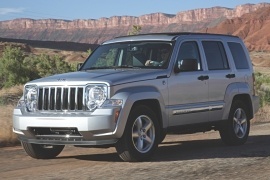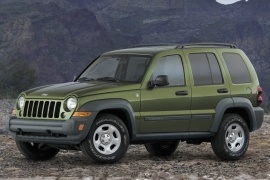
JEEP Cherokee/Liberty
Generations Timeline, Specs and Pictures

Jeep tried to make a breakthrough in the compact SUV market with the Liberty/Cherokee.
After the successful XJ model, which was produced between 1984 and 2001, its successors were not so trustworthy when it came to hard off-road. The 2007 model came to fix that. But it didn’t.
The second generation of the Liberty shared its platform with the Dodge Nitro. It featured a different styling with the specific, seven slats, grille. The flat and big headlights with mounted behind the bumper resembled those found on the Jeep Commander, which was another flop on sales. The rugged appearance was amplified by the black door handles with big buttons and the black door-mirrors. In the back, the flat tailgate with an independent open for the rear window was a good feature for transporting long items or to drop something inside from shopping without opening the entire liftgate.
Inside, the two-tone dashboard was matched by the colors used on the door panels. Like the Dodge, Liberty was not fitted with the best quality materials. The idea was to be able to wash all the trims with a hose. Beware of the CD-player slot though! The car offered seating for five adults. In the luggage area, a covered special compartment under the trunk floor allowed the storage of wet items without ruining the whole interior of the car.
From the technical point of view, the Liberty was fitted with a 3.7-liter V6 engine mated to either a 6-speed manual or a 4-speed automatic. Like the Dodge, the Cherokee was offered in Europe with a 2.8-liter turbodiesel engine supplied by WM Motori mated to a 5-speed automatic. Unfortunately, neither version was offered with a low-range gear for true off-road.

After a slow start and some not very cheerful appreciations from the customers, Jeep tried to improve the Cherokee/Liberty’s third generation.
Mercedes-Benz and Chrysler allied in 2001, and soon, the German carmaker helped Jeep to improve its products. The American carmaker chose the strategy to name the car Liberty on the North-American market, which created less confusion among its customers. It was no longer a rough off-road vehicle, like its predecessor, but designed more for a comfortable ride, and it could still tackle some tracks and forest paths.
From the outside, there were slight changes in the bodywork. Depending on the trim level, the car featured black or body-colored moldings over the fenders and side skirts. Its chromed-polished grille resembled the older Willy’s and helped the SUV integrate into the Jeep family. The fog-lights were integrated into the grille above the bumper, which was redesigned.
Inside, it featured an updated look for the dashboard and, especially, the instrument panel that sported white dials. The Cherokee/Liberty dropped its angular panels and rough-looking buttons from the previous generation. Its third-generation featured rounded shapes, circular vents, and a simple dashboard layout with only four gauges instead of six as before. But, at least, it featured a split-folding rear bench and headrests for the three people in the back.
Under the hood, Mercedes-Benz insisted on offering the 2.8-liter CRD diesel for the North-American market, which offered a great fuel-efficiency. Its emissions, though, were too high for several states, but its high torque at low-end revs was convincing. It was available only for two years, and it succeeded in selling over 10.000 oil-burners in the first year.

Jeep decided to change the Cherokee XJ after 17 years into production and replaced it with the Cherokee/Liberty lineup in 2001.
While the Jeep Cherokee XJ was loved and appreciated for its off-road capabilities and small exterior size that made it easy to use in cities, the 2001 model was different, and not in a good way. There were many wrong things about the car, starting with the name. People, especially Jeep-people, didn’t like it, and they said that the 1984 Cherokee was a much better vehicle and, even more, a better-looking one.
In 2001, Chrysler was in the DaimlerChrysler alliance, and the management thought that the boxy-looking vehicle’s design was gone. The designers tried to offer a rounded shape, with a Wranger-inspired front end. The two-round headlights and the seven vertical slats on the grille were already a trademark for Jeep, and the marketing department decided to install them on the 2001 Cherokee/Liberty. To make the car looks like it was ready to tackle hard off-road tracks the vehicle featured plastic moldings over the wheel arches. Unlike its predecessor, the 2001 model featured the spare wheel mounted on the tailgate, and not inside as before.
There was a big improvement on the interior. It featured more comfortable seats for up to five adult passengers. Instead of angular panels and rough-looking buttons, the 2001 Cherokee featured rounded shapes, circular vents, and a simple dashboard layout with only four gauges instead of six as before. But, at least, it featured a split-folding rear bench and headrests for the three people in the back.
Under the hood, Jeep installed a choice of gasoline and diesel engines. While the former was offered especially on the U.S. market, the latter were in high-demand on the European continent.

The Cherokee XJ was already an old vehicle but still sold in high numbers, so Chrysler decided to give it a facelift in 1997.
Born in 1983, the Cherokee was the result of a troubled love affair between American Motor Corporation and Renault. Its light, unibody construction was unique on the market and marked the end of heavy off-road vehicles. By 1997, Chrysler already integrated the Jeep brand and the French carmaker was gone. Chrysler was not ready to drop the compact 4x4 vehicle from the assembly lines, so it gave it a well-deserved facelift.
There was not much to do about the car’s exterior. Still, Chrysler’s designers revised the front fascia with its seven vertical slats. The metallic bumpers stayed, but they sported body-color with plastic ends. Its door-handles remained black with big push-buttons so they could be used with a gloved hand. In the back, there was a new, metallic liftgate.
Inside, Chrysler refreshed the dashboard that featured an extended cluster that covered the instrument panel and the center stack. The low-mounted seats offered a car-like driving position. Due to the short greenhouse, it was impossible to install higher seats. Its tall center console hid the tall transmission tunnel.
Under the hood, Jeep offered a 2.5-liter inline-four engine as the base model, but only for selected markets. In the U.S., the Cherokee featured only the 4.0-liter inline-six unit paired either to a five-speed manual or a four-speed automatic. The 4x4 versions featured a transfer case with low-range gear.

The Cherokee is probably one of the best known models for American company AMC.
The model that started out production in 1984 is actually the second generation, the one called the XJ, the successor of the SJ. It was the first unibody (monocoque) car made by Jeep. The XJ has a more European feel due to the implication of the engineers over at Renault in the development of the car. The Cherokee Xj was offered in 2-door and 4-door versions. The XJ was replaced later with the XJC (Grand Cherokee).
The 1984 Cherokee was the one to revolutionize the American SUVs, having a shorter wheelbase and a shorter length, thus being lighter a weighing 1000 pounds less compared to its predecessor. A pick-up version was also released and was named Jeep Cherokee Comanche.
The car’s interior was nothing luxurious, rather very well thought to suit the needs of the buyer. It was a basic, functional interior.
The Cherokee was available in three trim levels: Base, Pioneer and Chief.
The Cherokee was offered in both three- and five-door configurations, each having the same track and wheelbase. There were 13 trim levels to choose from including limited editions like the Pioneer Olympic Edition and the 60th Anniversary, which came with special badging and carpets, air conditioning, and other special features.























































